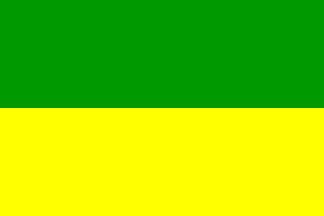 klaus-michael schneider
klaus-michael schneider
Keywords: cundinamarca | fosca | oriente |
Links: FOTW homepage | search | disclaimer and copyright | write us | mirrors

Last modified: 2021-08-26 by  klaus-michael schneider
klaus-michael schneider
Keywords: cundinamarca | fosca | oriente |
Links: FOTW homepage |
search |
disclaimer and copyright |
write us |
mirrors

by Carlos Thompson (based on Felipe carrillo
report), 28 August 2004
See also:
Other sites:
The Municipality flag is a rectangular cloth or fabric that is
fastened to the pole at one of its ends. The cloth is cut
horizontally and at the middle by two colors or tinctures, by
whoich Fosca is represented. In the upper part is the Green
tincture and in the lower part is the yellow tincture. They can
be understood in two ways: The green, as has been said in the
description of the shield, is of similar color to fresh grass, to
emerald, is symbol of hope, of fertility, of vegetation. As such
it can be understood as the wealth or the Municipality,
manifested in the agricultural production of the fields and the
vegetation that sustains Fosca economy. Yellow, described in the
shield as green, is the color of gold, of sugarcane and the color
of the sun. It obviously refers to the wealth of the soil, not
only by the gold, of which we asume have been deprived, but the
wealth that for a farmer means his parcel of land, his native
soil, as well as the same characteristic of the Municipality of
having been a great producer of sugarcane, that is still being
produced but not at the same rate, and finally and as logical
reason, it referes to the great light that dawns in Fosca each
morning with great shine by the geographic situation, East
Cundinamarca. Translation: Yellow stands for the wealth of the
soil: gold (that thy believe stripped of) and sugarcane (formerly
an important part of economy, today less so), as well as the
sunlight, of this eastern municipality. Other explanation that
can be given to the flag is that, due to its geography, the
Municipality has two regions that can be easily differenciated by
its climate, customs and agricultural products...
In the upper part you find the deep green that refers to the veredas
[Vereda is a rural subdivision of a municipality. My
University of Chicago dictionary translates it as small village,
but a vereda does not need a village.] located in the upper part
of the Municipality of Fosca, where you can diferenciate the
highlands that allows a great agricultural variety as potato and
products of cold climate, which allows to find these veredas year
around with green depth of varied cultivations.
In the lower part of the flag and with yellow color it is
represented the veredas located in the lower parts of the
Municipality, they are warmer lands characerized by products like
sugarcane, coffee, and by being a region that is know as a
chicken producing region. This interpretation, before calling for
division, pretendes to show the great unity that is lived in this
beloved region.
[Summary: Horizontally divided green over yellow (no surprise:
the flag is a rectangular piece of cloth, hoisted from one end.)
Green is the color or emerald and grass and means hope, fertility
and vegetable wealth. Yellow is the color of gold, sugarcane and
sun.
Interpretation one: Green stands for agricultural wealth that
sustains Fosca economy. Yellow stands for soil wealth (including
stripped gold), sugarcane, and morning sunlight (marking that
Fosca is located at the East of the department).
Interpretation two: Colors stand for upper and lower Fosca and
its different climates, customs and products.]
Jairo Alonso Méndez Méndez (traslated be Carlos
Thompson), 10 January 2004
cunfs.gif)
by Carlos Thompson, 28 December 2004